Speech A Proper Role for Monetary Policy

Bernie Fraser
Governor
Talk to Annual General Meeting Dinner of the Committee for Economic Development of Australia
Melbourne –
Last month in Hobart, I talked about monetary policy and the banks, and various other issues. Tonight I want to concentrate on the role of monetary policy. In particular, I want to expand on what I see as its dual roles – to keep downward pressure on inflation, while seeking to avoid excessive swings in economic activity.
The Dual Roles of Monetary Policy
I said in Hobart that the monetary authorities have ‘set themselves not one but two tasks – to avoid (in the current downward phase of the cycle) too severe a contraction in domestic activity and, at the same time, to stay in the fight against inflation.’ I went on to say ‘I believe it is entirely appropriate – and accords with economic and political realities – for the Reserve Bank (as well as the Government) to fix upon both objectives, even though two balls are harder to keep in the air than one.’
This seems to me to be a proper, commonsense approach to monetary policy, and one that would be generally endorsed by practitioners in most countries. Some purists, however, would not accept that there can be anything other than one objective, namely price stability. They would no doubt argue that to have two objectives is like trying to have your cake and eat it too.
I think this is an unreasonable simplification caused by taking the language too literally. An analogy might help here. If I am driving to Canberra, I might say that I wish to get there as quickly as I can, but I do not mean it literally. If my only objective was speed, I would drive recklessly and risk not getting there at all. In reality, of course, there are two objectives – to get there quickly, but also to maintain certain standards of safety along the way. Similarly, monetary policy aims to get results on inflation, but also to avoid excessive costs in terms of lost output, unemployment and business failures along the way.
If we pursued one task to the exclusion of the other, the overall result would be unsatisfactory.
In practice, no one gives all the weight to inflation and none to the ‘cycle’. No one has argued that interest rates should not have been reduced to some extent during the course of 1990. The fact that some lowering of rates was widely seen as necessary can be taken as general acceptance of the proposition that monetary policy cannot sensibly be confined to squeezing out inflation. If that was the only objective, the maximum effect would have been achieved by keeping rates at their earlier peaks (or even raising them further).
Similarly, it would be unwise to conduct monetary policy only with a view to smoothing the cycle – a shorthand for seeking to avoid excessive economic fluctuations, whatever their source. A couple of decades ago many countries did so but this approach came to grief as inflation rose around the world. Monetary policy everywhere now has price stability as a major objective. If the cycle was the only objective, interest rates would be lower than they are now.
To get the balance right, we need to see the effect of monetary policy on the two objectives and how they interact.
Monetary Policy and the Cycle
Although the weight attached to it has varied at different times, smoothing the cycle has been a major focus of monetary policy in recent years. By early l988, for example, it was apparent that spending in the economy was beginning to run too fast and between April 1988 and mid 1989 short term interest rates were raised progressively by 7 percentage points. For a time these rising rates had little effect in slowing the economy – the fastest rates of demand growth were recorded in the December quarter 1988 and the March quarter 1989. This situation can be explained in part by the euphoria associated with sharp increases in asset prices and sustained growth in business profits – conditions which encouraged further borrowing, notwithstanding very high interest rates.
In a deregulated financial market, such as we now have in Australia, credit cannot be rationed by quantitative means. Instead, it is necessary to change the price of credit, as measured by its real interest rate. As Graph 1 shows, when the authorities saw that too much use was being made of credit, they raised its price very sharply.
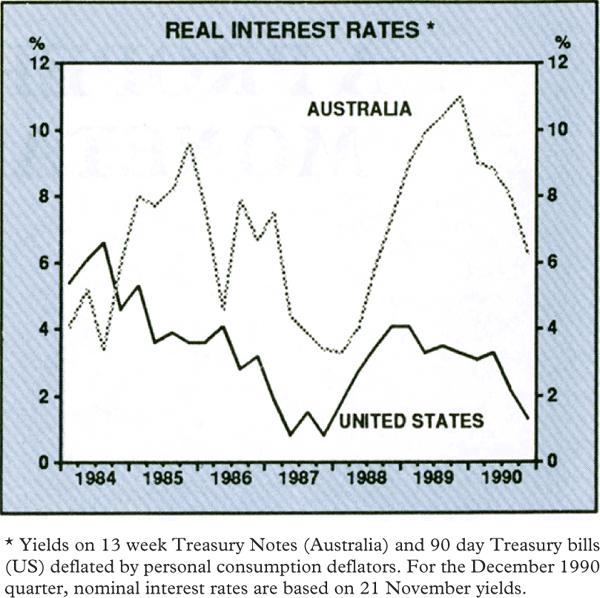
Why businesses continued to borrow – and banks to lend – at such historically (and internationally) high real rates of interest remains a puzzle. Rising asset prices – and the associated inflation and tax biases favouring investment in property – are part of the explanation, but only part. Why, we might ask, did borrowers and lenders continue to expect large, on-going increases in asset prices when history would have told them that boom conditions do not last forever?
In such a market, no one knows what level interest rates would have to reach to choke off the boom. Prime rates of 20 per cent plus did not work quickly to turn things around. Should we have tried rates of 30 per cent? I think not. Rates as high as that could well have been needed to chop off the borrowing (and lending) excesses but they would have been absolutely devastating for the rest of the economy, including the household sector and the traded-goods sector. That was hardly a price worth paying to prevent some highly geared asset speculators (and their bankers) from going too far.
By the middle of 1989, high interest rates were starting to bite into cash flow and profit prospects, and these in turn affected asset values. By the beginning of 1990, the economy was slowing and asset prices were recording further falls. Monetary policy responded to this new phase of the cycle; in five steps interest rates have fallen 5 percentage points since January. The lower interest rate will ease the strain on cash flows and improve the arithmetic of prospective investment projects.
The exchange rate is also one of the transmission channels of monetary policy. Interest rate changes clearly have implications for the exchange rate but, as the events of 1990 illustrate, other factors are sometimes more important. Indeed, prior to the most recent reduction in interest rates on l5 October, the $A was a little higher against the $US (and about the same against the TWI) than it was in January, before the easing of monetary policy commenced.
It was a surprising show of strength by the $A, given both the sharp decline in interest rate differentials (particularly against the Yen – see Graph 2) and the steady downward trend in commodity prices – see Graph 3. It was also an unsustainable degree of strength, in the sense that the $A needed to be lower to help reduce the current account deficit and contain the growth of foreign debt.
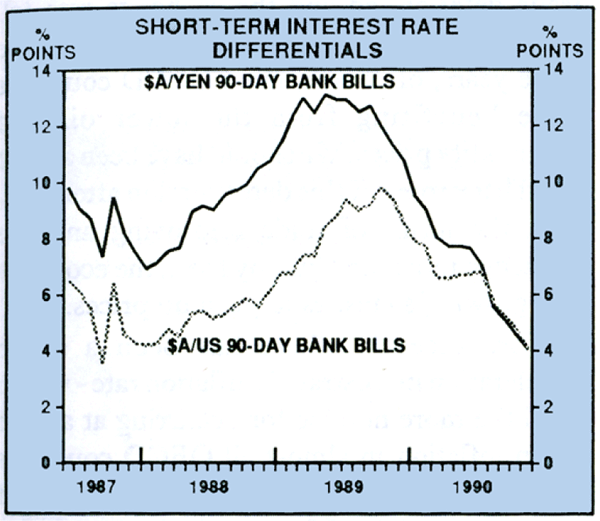
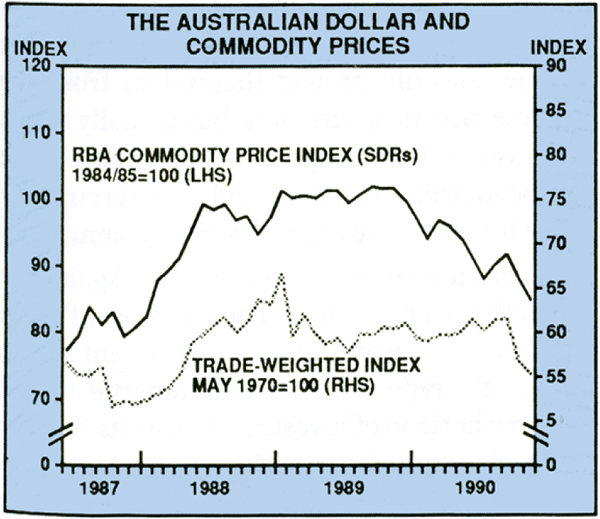
Since the end of September, however, the $A has depreciated, in an orderly way, by about 10 per cent against the TWI. Against the $US it has fallen 7 per cent, and against the Yen, 15 per cent. This fall in the value of the $A will also lend some support to demand, through encouragement of exports and import replacement.
In summary, and with due allowance for lags, monetary policy clearly has a substantial influence on the economic cycle. This is not the place to canvass particulars of whether or not policy needs to be eased further but a few general observations can be made:
- the 5 percentage point reduction in short term interest rates since the beginning of 1990, together with the l0 per cent depreciation of the $A, amounts to a substantial easing of monetary policy;
- that easing can be expected, with lags, to have a reviving effect on spending – the extent of the lags will depend on several factors (including confidence levels among consumers and investors) but, provided the world does not slide into deep recession (which seems unlikely), the Australian economy should be looking healthier in the second half of 1991; and
- while we should strive to avoid wide fluctuations in the cycle – and the lost production and other costs that go with them – we have to accept that monetary policy cannot ‘fine tune’ the economy to smooth out all the bumps. There are significant and unavoidable lags in recognising turning points, and in framing and implementing policy measures. In addition, Australia, more than most countries, is subject to frequent external shocks.
Regrettably, policy can never fully (or even largely) offset the swings of the cycle. If we try to force monetary policy to do more than it is capable of, we will be disappointed not only in its counter-cyclical performance, but also in its anti-inflation role.
Monetary Policy and Inflation
This brings me once more to the topic of inflation, which I am delighted to see featuring so prominently in public discussion of economic affairs. Indeed, there is now the very real prospect of Australia joining the ranks of the low inflation countries. We must not allow this once-in-a-decade opportunity to slip through our fingers. Only when it is clear that inflation is well and truly under control can we look forward to sustainably lower interest rates. We are not yet there – the petrol price rises have still to be absorbed and the December quarter numbers will be less flattering – but we are knocking on the door.
As Graph 4 shows, Australia held its own with the low inflation countries during the l960s and it is not being fanciful to imagine that we can be in that position again.
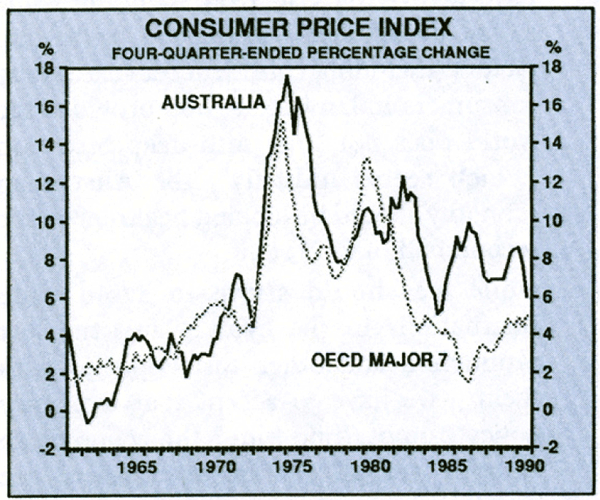
The dramatic step-up in inflation in the early 1970s reflected the boost given to demand by the commodity price boom, as well as the cost-push pressures associated with oil price rises and some unfortunate policy decisions. The same period also serves as a reminder of how quickly inflation can ratchet up to a higher level and how difficult it is to wind down again: even with modest economic growth in the second half of the 1970s, inflation remained stubbornly ingrained at around 10 per cent.
Substantial progress was made in 1983/84, when the combination of the 1982 wage freeze, a slack economy and the Accord brought about a significant step down in inflation. This progress was lost in 1985 and 1986, when the terms of trade deteriorated and the exchange rate fell sharply, increasing import prices – during the same years, of course, most OECD countries were benefiting from the lower oil and commodity prices. We should have been able to wind back some of this deterioration after l987, with the terms of trade improving and the exchange rate rising but, by then, the economy was growing so fast as to push up prices.
More recently, there has been a sharp deceleration in Australia's inflation rate – which is all the more notable for occurring at a time when inflation in almost all OECD countries has moved up. The gap between Australia and the seven major OECD countries is now smaller than it has been for some time, but we cannot take any particular pleasure in the deteriorating performance overseas. Nor should we set our sights on only matching some OECD average inflation rate; we should aim to do better.
This is not because lower inflation is a goal in itself but because lower inflation can bring substantial economic and social benefits. I have talked earlier about the benefits of lower inflation – and of the costs of higher inflation. Although the costs are difficult to quantify, persistent inflation of even moderate proportions raises important equity issues. We all know how some people not only protect themselves from the adverse effects of inflation, but actually profit from them. For everyone who benefits, there will be someone who loses, and the losers usually come from the weaker groups in the community.
Inflation also harms incentives. Again, we have all seen how people, in harnessing inflation for their own profit, distort investment flows, both in the type of investment undertaken and the time horizon of investment projects. We are up to our ears in office buildings when what we need most is more long term investment in export competing and import replacing industries. As Graph 5 shows, the prices received by producers in exporting and importing competing industries, relative to prices in the domestic economy as a whole, have slipped a good deal over recent years, i.e. prices in the non-traded goods sector have risen faster than prices in the traded goods sector. There are many factors at work here but a better investment mix could be expected if domestic inflation were lower.
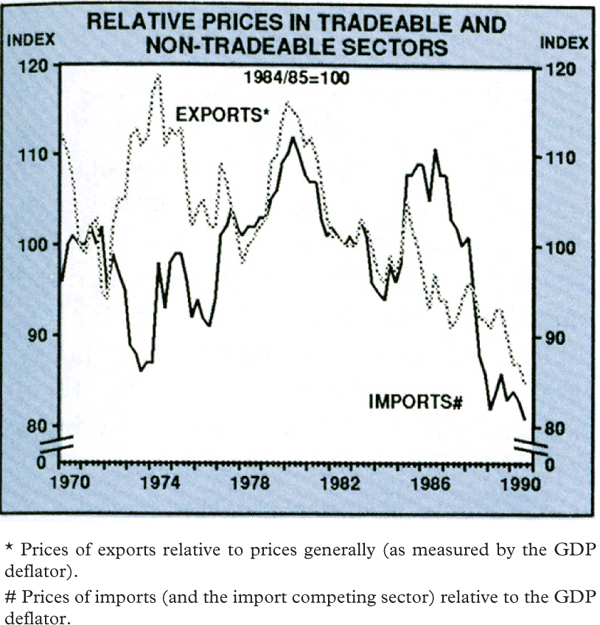
In terms of international competitiveness, Australia has lost much of its earlier gains over recent years (see Graph 6). Again, there are many factors involved, only one of which is the exchange rate. But where does the exchange rate fit into current monetary policy?
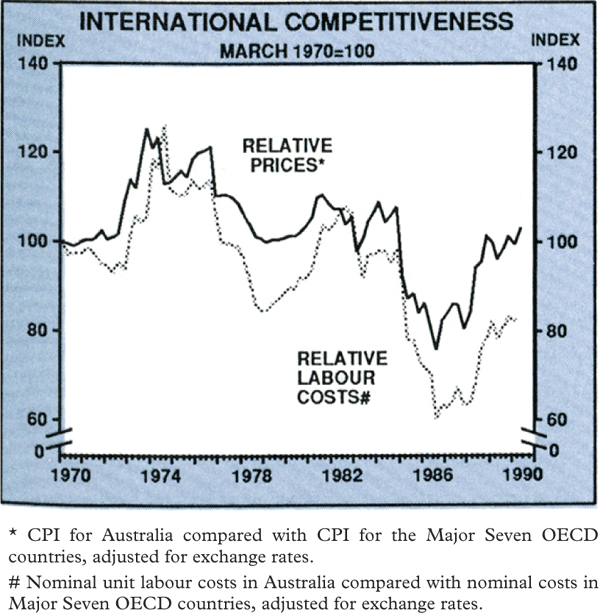
One consequence of the deregulatory process is that monetary policy no longer works solely through interest rates and bank balance sheets: an important part of the channel now is through the exchange rate. This could be seen clearly in 1988 and 1989, when higher interest rates (along with higher commodity prices) helped to push up the exchange rate, which served to ‘spill’ some of the excess demand into imports and to lower import prices, with favourable effects on inflation. The cost, of course, was the loss of international competitiveness shown in Graph 6. The more recent fall in the exchange rate will unwind the process to some extent but not enough to restore competitiveness to the levels achieved in 1986.
Falls in the exchange rate pose dangers for our inflation rate. That is why we have to concentrate on containing inflation, rather than trying to achieve a particular exchange rate in order to improve competitiveness. Greater competitiveness is essential if we are to lower the current account deficit, but this improvement has to come about through keeping the domestic economy running at an even pace and keeping our inflation rate down – not by inflating faster than the rest of the world and attempting to offset this by continuing depreciations. One thing that is very clear is that we cannot improve our competitiveness in a structural sense by pursuing a loose monetary policy.
In the short run, monetary policy can influence the exchange rate but over the longer term the main contribution monetary policy can make to international competitiveness is through helping to create a low inflation environment. Lasting encouragement to producers in the export and import competing sectors will come not from a loose monetary policy pushing down the exchange rate, but from lower inflation and other fundamental changes which encourage saving and investment in internationally competitive areas.
Reconciling the Inflation and Cycle Objectives
Monetary policy, then, has to be concerned with both prices and output. Moreover, as well as trying to keep both balls in the air, policy makers should also allow for the system's bias towards higher, rather than lower, inflation. In particular:
- there is usually a greater readiness on the part of the authorities to respond to a weakening economy than to an economy which is tending to overheat;
- producers and workers are more ready to raise their prices and wages when demand is strong than they are to lower them when demand is weak; and
- inflationary expectations are more easily ratcheted up than down.
From the point of view of inflation control, these biases probably require policies to be somewhat firmer than they would need to be if the implications for inflation were symmetrical throughout the cycle. At the very least, they require that the authorities not allow cyclical objectives to overwhelm inflation objectives, even when taking short term action to counter excessive swings in activity.
In the current context, this means being careful not to chase the economy all the way down, i.e. not pushing interest rates down every time we get news of further weakness in activity and employment. While there is little danger that a lower rate of interest now would cause the economy to immediately get up and run away, the real risks are in the lags and biases referred to earlier: if interest rates were to be lowered too far now, it would risk having policy too loose when the economy moves into the next upswing. The gains now emerging on inflation have entailed considerable pain and we need to ensure that these gains are not frittered away when the economy picks up again. The authorities are very much alive to these risks.
Apart from maintaining a firm hand to avoid such risks, what else can be done to build on the present opportunity to push inflation sharply lower?
In essence, we have to find an acceptable and effective way to reduce price expectations. This is the element of inertia that stops prices from falling in response to slower activity; they effectively put a floor under price increases. When people build higher price expectations into their price and wage decisions, it becomes harder to wind inflation down, even after the active forces driving it (such as overheated demand and cost-push pressures) have abated.
How do we affect expectations?
Some have suggested that the best way is to limit the discretion of the authorities by tying their hands with ‘targets’ of one kind or another – such as a monetary aggregate, or inflation, or a specific exchange rate. The idea is that a ‘target’ – effectively a pre-determined commitment that limits the room for the authorities to manoeuvre – would prevent policy from being diverted by short term considerations. This is also seen as having a favourable effect on price expectations.
None of this has much appeal to me:
- We flirted with monetary targeting in the late 1970s and early 1980s but, for whatever reasons, it clearly did not deliver lower inflation. There is no point in having a fixed monetary rule if it gives the wrong answer – and the evidence of the 1980s everywhere is that there is no holy grail – no simple, golden rule which policy makers can follow in order to avoid inflation. At the end of the day there is no substitute for the exercise of judgment.
- Whether an inflation target – such as a commitment to achieve a certain rate of inflation within a set period – would possess sufficient credibility to influence price expectations would depend on a number of factors. As a minimum, it would need to be a government (not just a central bank) target, and be backed by all available policy instruments (not just monetary policy).
- Tying a country's currency to that of a low-inflation country has succeeded in lowering inflation in several European countries, albeit at some costs in terms of lost output and employment during the transition. This approach, however, works best for groups of countries which have similar productive structures. It would not make sense for Australia, with its particular industrial structure and heavy dependence on certain commodities, to tie its exchange rate to a country (e.g. Japan) with very different structures – it would rule out exchange rate changes when they might well be a critical part of the adjustment to external shocks.
If simple rules and ‘targets’ are out, what are the alternatives?
Would tough talk quickly change expectations? All the evidence says that this does not work: the authorities have to be tough as well as talk tough.
How tough? If we were to run the economy well below capacity for a prolonged period, this would probably do the job – but the costs would be unacceptably high.
This leaves us with the current strategy. In this approach, the authorities emphasise their commitment to reduce inflation in the medium term and back this by firm, credible but non-doctrinaire actions. Credibility is critical in determining the costs of reducing price expectations: the public need to be convinced that inflation can be lowered without putting the economy on the rack. Credibility, it has been said, is ‘difficult to acquire, easy to lose and never to be taken for granted’.
The present strategy is credible. It is delivering results, as the numbers over the past year or so (and not just the September quarter CPI) demonstrate. The recent fall in 10-year bond yields suggests that price expectations are coming down, while the wage/tax trade-off announced last week is an example of a response which can consolidate and build on these expectations.
We are now well placed to really push price expectations lower. Apart from uncertainties over oil prices, there are no active forces driving up inflation at the moment: economic activity is not putting pressure on prices and the earlier imbalance between the wage and profit shares of national income has been largely corrected, i.e. the profits share has been restored. We might well say, in effect: ‘let's divide up the national income “cake” as we do now, so that we all have the same share in real terms. But let's do it in an environment of price stability rather than one in which prices are rising at 6 per cent.’
That, no doubt, sounds rather fanciful – but the thought is no longer as fantastic as it would have seemed a short time ago.
Conclusion
The burden of this talk is that the proper role for monetary policy goes beyond the simple rule: ‘when the economy is running too fast, tighten; when it is too slow, ease interest rates’. Monetary policy can have a powerful role during the cycle, particularly in slowing an overheated economy. But it can make a lasting contribution when it helps to lower inflation.
When the economy is running too fast, there is no conflict between the anti-inflation and anti-cyclical objectives of monetary policy. It is probably now, when the economy has slowed, that there is greater potential for getting the balance wrong. The temptation is to respond to the immediate problem – the cycle – and ignore the longer term task of getting inflation down. Much, clearly, hinges on getting the balance right over the next year.